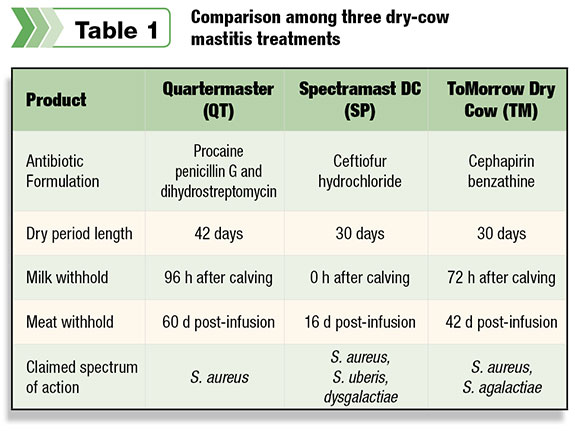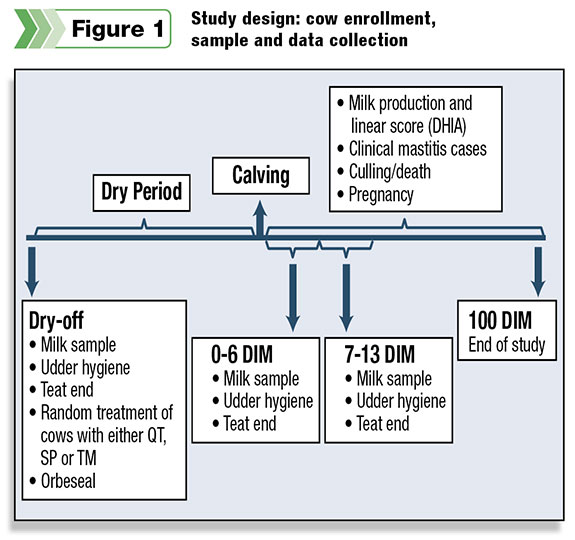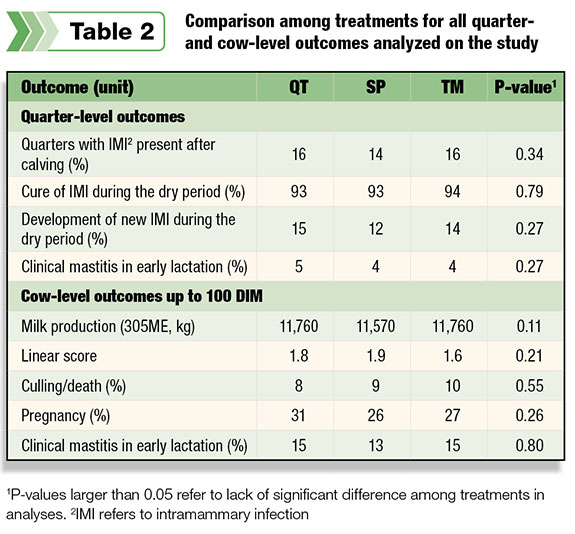Blanket dry cow therapy, the intramammary treatment of all quarters of all cows in the herd with a long-acting antibiotic formulation at dry-off, is one of the practices recommended by the National Mastitis Council for mastitis control.
The main purposes of dry cow therapy are to eliminate existing intramammary infections and to prevent new infections occurring during the dry period.
According to the National Animal Health Monitoring System, blanket dry cow therapy is currently adopted in more than 72 percent of U.S. dairy herds, and there are at least seven different products commercially available.
Even though all available products have been proven efficacious against a negative control (no treatment) in order to receive FDA approval for licensing, the efficacy of dry cow therapy products in direct comparison to one another is lacking in North America.
The following briefly reports results from one clinical trial which compared three commonly used dry cow therapy treatments.

The three products compared were Quartermaster (QT, Zoetis Animal Health), Spectramast DC (SP, Zoetis Animal Health) and ToMorrow Dry Cow (TM, Boehringer Ingelheim Vetmedica, Inc.).
Characteristics of each product regarding antibiotic formulation, milk and meat withhold period, required dry period length and spectrum of action are provided in Table 1 .
The study was conducted as a collaborative effort between the University of Minnesota, Iowa State University and University of California – Davis.
A total of 1,091 healthy cows from six different herds participated in the study: one from Minnesota, one from Iowa, two from California and two from Wisconsin. The herds were visited weekly on the day of dry-off.
Milk samples were aseptically collected from all quarters before administering dry cow therapy. Cows were then randomly assigned to receive one of the three dry cow therapy treatments and were infused with an internal teat sealant after the dry cow therapy treatment.
After the cows calved, aseptic quarter milk samples were collected again during the first and second week post-calving. All milk samples were submitted to laboratories for bacteriological culture.

Cows were followed until 100 days in milk (DIM) to collect information on clinical mastitis events, milk production, linear score, culling or death events and pregnancy. The study design is shown in Figure 1 .
Both quarter-level and cow-level outcomes were investigated; the short-term quarter-level outcomes included presence of subclinical infection at the first week post-calving sample, quarter acquisition of new infections during the dry period and cure of pre-existing subclinical infections in the quarter during the dry period.
A bacteriological cure was defined as the disappearance of the pathogens (in both post-calving samples) that were originally present in the milk sample collected at dry-off.
A new infection was defined as appearance of new or different pathogens in the milk sample collected in the first week post-calving.
The long-term outcomes at the cow level included milk production, linear score, risk for culling or death and risk for getting pregnant in the interval from calving to 100 DIM.
Effect of dry cow therapy treatment on risk for a clinical mastitis event was evaluated at both the quarter and cow levels for the interval from calving to 100 DIM.
In addition to the effect of dry cow therapy, the study also examined the effect of other factors on the mentioned outcomes, including teat-end condition at dry-off, udder hygiene score at dry-off, cow parity, dry period length, previous milk production and previous linear score.

Results showed that there was no difference among the three dry cow therapy treatments evaluated when examining quarter-level cure rate, new infection rate or risk for presence of infection after calving ( Table 2 ).
At the cow level, analyses showed that milk production (captured as 305ME), linear score, risk for culling or death and risk for getting pregnant were also not different among the three dry cow therapy treatments.
Finally, the proportion of quarters and the proportion of cows experiencing a clinical mastitis event in the interval from calving to 100 DIM were not different among the three dry cow therapy treatments (Table 2).
The study also showed some interesting additional findings.
Cows with elevated linear scores in the previous lactation were at increased risk for having a subclinical infection present at dry-off, elevated linear score in the subsequent lactation and an increased risk for experiencing a clinical event during the first 100 days of the subsequent lactation.
Quarters with rough or cracked teat ends were at increased risk of developing new infections during the dry period, and cows with dirtier udders at dry-off were more likely to have a subclinical infection present at dry-off.
As compared to younger cows, quarters from older cows were more likely to develop a new infection during the dry period and to experience a clinical mastitis event in early lactation.
Older cows were also more likely to have elevated linear scores, a clinical mastitis event, and be culled during the first 100 days of the subsequent lactation.
In conclusion, the three products appeared to work equally well.
This study supports the idea that producers can potentially put aside concerns about differences in product efficacy when selecting dry cow therapy products to use in their herds and instead focus on other product characteristics such as cost, dry period length, and meat and milk withhold period.
References omitted due to space but are available upon request. Click here to email an editor.





